The city of Jaipur is a cultural center with a university, theaters, cinemas, museums and the city center has been a UNESCO World Heritage Site since 2019. The city was founded in 1727 and gained independence in 1949/1950, when hegemony was replaced by British rule. It is a state within a state in India that holidaymakers visit and where their own culture can be found.

The old town and its sights
The old town is painted pink and surrounded by a wall ring, including the Tripolia Gate and the Iswari Minar Swarga Sal minaret inside. In the city and its lively streets there are different notions of religions, which range from Buddhism, Islam and other religions from the Asian region. Other attractions include the city palaces of Hawa Mahal, Jai Singh II and the Palace of the Winds, which is the old observatory. The area includes a garden and a museum that is regularly visited by tourists. In the observatory you can see a sundial and another 18 instruments from the astronomical field, with which the sky was observed or is still being observed if the astronomical center is visited at night in India. Among the palaces is the Rambagh Palace, which belonged to the last Maharajah of Jaipur, which is now a hotel and vacationers can feel like royalty there next to the entertainment. The town has a fortress or fort that served as a retreat for the royal family. In Ram Niwas Park there is the Albert Hall and the Central Museum, which exhibits evidence of Buddhist history.
Image of the colorful and diverse city in the busy street
Overall, it is a colorful and diverse city that carries many different cultures and stories from the past and present into the future. The streets in which you can see the little things of the city are significant. The busy streets have stalls, markets and musicians performing snake dances at a snake festival. A picture from the oriental area is used. The man who wears a turban and white linen to protect himself from the heat. He lies on a (flying) carpet and blows a flute to lure a snake out of a wickerwork, which performs a dance according to the melody. It is a form of snake conjuring and solo entertainment. It’s a glow to make the snake dance. This means that the snake does not dance in real life, but sees a certain danger to which it acts defensively.
How the “snake conjuring” works and what is really behind the conversation
The animals for the snake dances are in a dark basket. The snake is caught in the wild. If you open this, the animal fixates itself on the first light or the opponent, which can be threatening to the snake. The snake orients itself to the rhythms created by the flute and the movements. Snake charmers are trainers in India and Southeast Asia who have magical abilities (hypnosis). They are said to have supernatural abilities to make contact with spirits and magic or to learn great secrets for the reality of the snake. On the other hand, for some sections of the population they have the status of charlatans.
 Dansk
Dansk Deutsch
Deutsch Español
Español Français
Français Indonesia
Indonesia Italiano
Italiano Magyar
Magyar Melayu
Melayu Nederlands
Nederlands Polski
Polski Português
Português Русский
Русский Română
Română Tiếng Việt
Tiếng Việt Türkçe
Türkçe Українська
Українська български
български Ελληνικα
Ελληνικα 한국어
한국어 हिन्दी
हिन्दी 日本語
日本語 简体中文
简体中文




